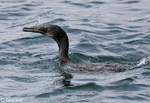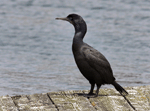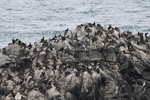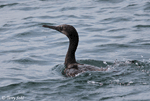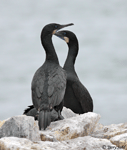| Length: 34 inches | Wingspan: 48 inches | Seasonality: Non-resident in South Dakota |
| ID Keys: Black overall, light chin patch, black bill, short tail. Breeding adults have a bright blue pouch below the base of their bill | ||
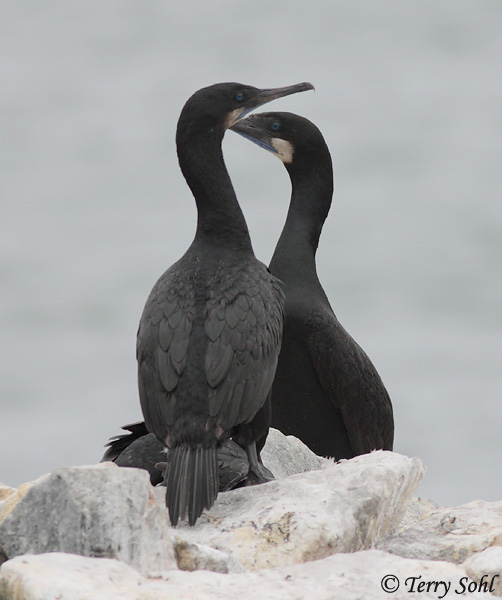 The
Brandt's Cormorant is one of three cormorant species commonly found on the
west coast of the United States. They are found from southern Alaska
to northern Mexico, nearly always on salt water near the coast. Their
dark overall coloration is similar to the other two species found on the
west coast (Double-crested
Cormorant, Pelagic Cormorant). However, they can be readily
distinguished from these species by the lighter colored "chin" patch, and a
bright blue gular patch on the lower jaw when breeding.
The
Brandt's Cormorant is one of three cormorant species commonly found on the
west coast of the United States. They are found from southern Alaska
to northern Mexico, nearly always on salt water near the coast. Their
dark overall coloration is similar to the other two species found on the
west coast (Double-crested
Cormorant, Pelagic Cormorant). However, they can be readily
distinguished from these species by the lighter colored "chin" patch, and a
bright blue gular patch on the lower jaw when breeding.
Habitat: Breeds on islands and high slope areas and the tops of cliffs on the mainland. Non-breeding birds often stay close to breeding colonies at all times of the year, but may also sometimes be found foraging well out at sea.
Diet: Feeds mostly on fish, but will also sometimes each crustaceans, shrimp, squid, and other marine creatures.
Behavior: Strong swimmers and divers, they forage by swimming on the surface and diving up to 150 feet below the surface in pursuit of fish.
Nesting: Breeds in colonies, sometimes mixed with other seabirds. The nest is built of seaweed and the bird's own droppings, and is placed directly on the ground. Between 3 and 6 eggs are laid, and both parents will help to incubate them. Upon hatching, both parents help to feed the young, using regurgitation of caught fish.
Song: Usually silent away from their breeding grounds. They do make very quiet grunting and croaking sounds at the nest.
Migration: Considered a permanent resident throughout much of their range. However, some non-breeding birds do disperse outside of typical breeding areas, particularly southward along the Mexican coast.
Interactive eBird Map: Click to access an interactive eBird map of Brandt's Cormorant sightings
Similar Species: In range, most likely to be confused with the Pelagic Cormorant or Double-crested Cormorant.
Conservation Status: Populations may be decreasing in parts of their range, but they are still widespread and common in many areas. The IUCN lists the Brandt's Cormorant as a species of "Least Concern".
Further Information: 1) USGS Bird Identification InfoCenter - Brandt's Cormorant
2) Channel Islands National Park - Brandt's Cormorant
3) Audubon's Guide - Brandt's Cormorant
Photo Information: Photo taken on July 26th, 2010 - Half Moon Bay, California - Terry Sohl
| Click below for a higher-resolution map |
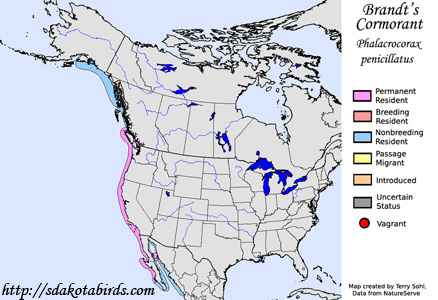 |
| South Dakota Status: Non-resident in South Dakota |
Additional Brandt's Cormorant Photos
Click for a higher-resolution version of these photos
